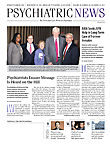Hurricane Sandy struck the New York area on October 29, 2012, leaving flooding, wind damage, power outages, and fires in its wake. The region still hasn’t fully recovered but appears to be on its way, say area psychiatrists.
Thousands of people were displaced from their homes for months—or longer. Community infrastructure and facilities such as hospitals, electrical service, houses of worship, schools, and group homes were damaged, destroyed, or closed.
The official mental health response organization for Sandy is Project Hope, authorized under the federal Stafford Act, which provides funds for crisis counseling when a disaster “exceeds the capacity of the local services to respond,” said Project Hope Director Tamar Renaud, M.P.H.
“Project Hope works to validate the emotions of people affected by the storm, build resilience, and bring them out of isolation,” said Renaud. “People are grateful for someone to talk to.”
There also is more help for those who need it, she said. Anyone who uses Project Hope services at least three times is screened and can be referred more extensive mental health care. Program funding is limited, however, and will end in February,
The counselors are paraprofessionals, said Renaud. They do no therapy and require no mental health degree for their job, but they are supervised by social workers. They are drawn from local communities and thus are closely attuned to their neighbors’ plight.
“We hired members of the Muslim community on Staten Island, Russian speakers in Brighton Beach, and Chinese speakers in Lower Manhattan, for instance,” she said.
African American neighborhoods were a particular concern of Sidney Hankerson, M.D., M.B.A., an assistant professor of psychiatry at Columbia University and president of the Black Psychiatrists of Greater New York (BPGNY).
“In times of natural disasters like Sandy, mental health disparities get exacerbated, so we have to use culturally sensitive ways to engage people so they can receive mental health care,” said Hankerson in an interview with Psychiatric News.
In in some of the hardest-hit communities, like Canarsie in Brooklyn, African Americans affected by the storm often felt more comfortable seeking help in familiar settings like churches, barber shops, beauty parlors, or social-service agencies, said Hankerson. His organization and related professional groups went to those nontraditional sites to engage area residents who needed help.
In many cases, it is important to have a therapist of the patient’s ethnicity, said Vanessa Bobb, M.D., Ph.D., a psychiatrist at New Alternatives for Children and secretary of the BPGNY. “That decreases barriers, and patients will feel that the therapist understands them better and they will be less misjudged.”
“It was important after the storm to put pressure on policymakers and local leaders to make sure that services and resources were directed to areas outside Manhattan too,” said Bobb. “The response was slow at first, but things are coming along now.”
Out on Long Island, the Nassau University Medical Center (NUMC) faced another set of community problems. The hospital did not close, but many patients in the community were flooded out of their homes and had no place to continue receiving treatment because local mental health agencies were shuttered. Staff members were essentially homeless because of flooding or power outages. Plus, NUMC had to take in patients from Long Beach Hospital—and then find the staff to care for them, said Constantine Ioannou, M.D., NMUC’s vice chair for clinical affairs in the Department of Psychiatry and Behavioral Sciences. He discussed the situation at APA’s Institute on Psychiatric Services in Philadelphia in October.
Recovery was a bigger problem than the storm itself. A year later, Long Beach Hospital is still closed, and NUMC became the de facto backup service for patients who needed ongoing treatment but had nowhere to go.
“We were prepared for a short-term problem but not for a long-term shutdown of the mental health system or for the personal and professional strains on the staff,” said Ioannou. “In fact, the primary challenge may not be psychological trauma, but restoring ordinary, regular services.”
NUMC is now preparing for a future 30-day disaster-related disruption, with a focus on seriously mentally ill patients, said Ioannou. The hospital staff aren’t doing that alone, but are working to build links with county and state mental health officials and with contacts at other agencies and hospitals.
And there were other rays of hope once the storm passed, recalled Ronald Brenner, M.D., a child psychiatrist at St. John’s Episcopal Hospital in Far Rockaway, one of the hardest-hit areas and one with an ethnically, linguistically, and racially diverse population.
“If anything, the storm and its aftermath brought people together out of mutual concern,” said Brenner. ■
